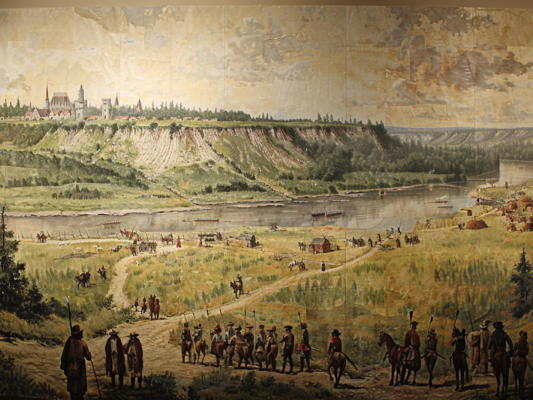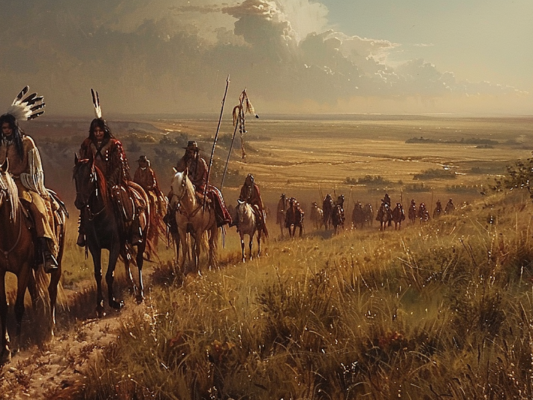A decree by King George III paved the way for Native American rights, though it led to the eventual loss of most tribal lands.
Native American chiefs and representatives from various tribes gathered from far and wide for a historic meeting. They converged at Fort Niagara in New York to forge a new alliance with the British.
In 1763, King George III declared that colonies could no longer seize Native lands or buy them without treaties. This was the first time Native Americans’ rights to their lands were acknowledged by North America’s colonial rulers.
Two thousand Native Americans came to Niagara to celebrate the proclamation and affirm their peaceful intentions towards British settlers. Before the first U.S. Indian reservations, colonial Britain established a vast “Indian Reserve” across its newly expanded territory.
Starting in 1763, English settlers were barred from traveling through or acquiring land west of the Appalachian Mountains—a vast area recently taken from France during the French and Indian War.
French and Indian War Reshapes American Territory
The proclamation was a landmark for Native American rights, though tribal members who celebrated with wampum belts didn’t know it would lead to the American Revolution and the loss of most of their lands.
Native Americans had been losing land steadily under British rule. “Each treaty expanded colonial land and reduced tribal lands,” explains geographer Charlie Grymes. The British desire to farm and settle along the frontier grew with their territory.
However, the British had a rival: the French, who claimed the Ohio River Valley in the 1750s. This fertile area held major trade potential, which Britain wanted to control. Conflict began in 1754, and by 1756, Britain declared war on France. Britain eventually won, and in 1763, the Treaty of Paris ended the war.
The treaty reshaped the American map, with Britain gaining Canada and all land east of the Mississippi. But British settlers’ desire for expansion and Native Americans’ fear of encroachment soon led to tension. Frontier settlers had seen their homes destroyed in the French and Indian War and now felt threatened by Native Americans.
Tensions boiled over in the borderlands. Ottawa chief Pontiac, who had allied with the French, led organized rebellions against British settlers, including an unsuccessful siege on Fort Detroit. His leadership sparked Pontiac’s War, where a loose tribal alliance attacked British settlements, causing panic among civilians.
Hundreds Perish in Pontiac’s War
Pontiac’s War resulted in about 500 British colonist deaths, and thousands fled. The lack of a decisive victory worried British officials, prompting George III to issue a proclamation to stem the conflict. It suggested that British settlers and Native Americans couldn’t coexist peacefully, shocking colonists who wanted to expand westward.
The proclamation aimed to let British subjects benefit from the new land but forbade settlement beyond the Appalachian Mountains. It stated that Native Americans under British protection shouldn’t be disturbed and that colonists couldn’t take or buy their lands without government approval.
Although Pontiac’s War increased racial divisions, creating an “Indian reserve” on land some colonists felt entitled to intensified tensions between settlers and the government.
The proclamation recognized Native Americans’ rights to their lands and aimed to protect them from fraud and abuse. It was seen as an inexpensive way to defend the British border by creating a buffer zone. Today, it’s viewed as a significant step toward recognizing Native American rights. Despite this, a black market for land emerged, as wealthy colonists felt entitled to Native lands.
The law laid the groundwork for the American Revolution and fueled future conflicts between settlers and Native Americans. The frontier soon became more contested, and the newly founded United States changed the fate of the continent’s indigenous people.
Indian Reserve Voided by American Revolution
Thirteen years after establishing the Indian Reserve, the proclamation became void in the United States. Between 1790 and 1847, new laws dictated how Americans could trade with and treat Native Americans.
The Nonintercourse Act recognized tribes’ special legal status, stating that U.S. citizens could only acquire land through treaties. However, it gave the U.S. a supervisory role, reflecting views of Native Americans as “uncivilized” and incapable of self-management.
This paternalistic attitude influenced U.S. policies toward Native Americans. By 1834, the U.S. designated most land west of the Mississippi as Indian Territory but had already begun pushing Native Americans out of their ancestral lands under the policy of “Indian removal.” This pressured tribes to trade their lands for territories further west.
As a result, Indian territory shrank as the U.S. signed nearly 70 treaties, opening vast tribal homelands to white settlement.



